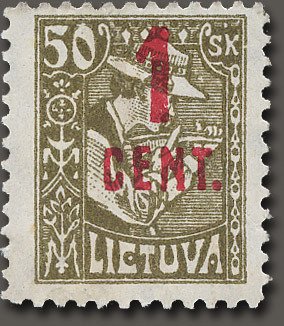Stamp: Peasant Sharpening Scythe (Lithuania 1922)
Peasant Sharpening Scythe (Lithuania 1922)
01 October (Lithuania ) within release Overprint in new currency goes into circulation Stamp Peasant Sharpening Scythe face value 1 Lithuanian centas
| Stamp Peasant Sharpening Scythe in catalogues | |
|---|---|
| Michel: | Mi:LT 147 |
| Stamp Number: | Sn:LT 140 |
Stamp is vertical format.
Printed in Aronshta and Andreyev lithography (Kaunas) Wires used in Berlin, Kaunas colored and standard issues and the addition of characters. Lithuanian-mail archives says that number. 141 (LT 141 F) with overprint ""1 cent."" on 30 skatikų (LT 4 Third Edition Berlin) has never been released. Lithuanian American V. Valantinas appointed to this post mark a significant study. It is possible that this stamp has been confused with the ocher-colored 30 skatikų sign (LT 53, Berlin Third Edition) U.S. Lithuanians collectors argue that much has been reprinted and other denominations stamps: 1 ct. on section 10. (LT 138), 15 ch. (LT 139), 20 ch. (LT 140), 40 ch. (LT 142), 2 cents on the 50 ch. (LT 148), 60 ch. (LT 149), 75 ch. (LT 150), 3 ct. on 1 gold. (LT 151), 3 gold. (LT 152), 5 gold. (LT 153). Variations: A Unperforated (200 pcs.) B Inverted overprint (10 3/4) C Double overprint (10 3/4) D Double overprint, one inverted (10 3/4) E Unperforated upper edge (11 1/4) F Unperforated right edge (11 1/4) G Green, with emerald hue (11 1/4) H Green, with emerald color, unperforated upper edge (11 1/4) I To the second half of the next stamp imprint (10 3/4)"Also in the issue Overprint in new currency:
- Stamp - Coat of arms face value 3;
- Stamp - Coat of arms face value 3;
- Stamp - Coat of arms face value 3;
- Stamp - Coat of arms face value 3;
- Stamp - Sower face value 3;
- Stamp - Sower face value 3;
- Stamp - Sower face value 3;
- Stamp - Reaper face value 3;
- Stamp - Grand Duke Kestusis face value 3;
- Stamp - Reaper face value 5;
- Stamp - Reaper face value 5;
- Stamp - Grand Duke Kestutis face value 5;
- Stamp - Coat of arms face value 5;
- Stamp - Coat of arms face value 5;
- Stamp - Grand Duke Kestusis face value 10;
- Stamp - Sower face value 15;
- Stamp - Black Horseman face value 25;
- Stamp - Black Horseman face value 25;
- Stamp - Black Horseman face value 25;
- Stamp - Black Horseman face value 50;
- Stamp - Black Horseman face value 1;
- Stamp - Coat of arms face value 2;
- Stamp - Coat of arms face value 3;
- Stamp - Coat of arms face value 3;
- Stamp - Coat of arms face value 1;
- Stamp - Coat of arms face value 1;
- Stamp - Coat of arms face value 1;
- Stamp - Coat of arms face value 1;
- Stamp - Coat of arms face value 1;
- Stamp - Coat of arms face value 1;
- Stamp - Coat of arms face value 1;
- Stamp - Coat of arms face value 1;
- Stamp - Coat of arms face value 1;
- Stamp - Peasant Sharpening Scythe face value 1;
- Stamp - Coat of arms face value 2;
- Stamp - Coat of arms face value 2;
- Stamp - Black Horseman face value 25;
- Stamp - Grand Duke Kestutis face value 5;
- Stamp - Sower face value 30;
Stamp Peasant Sharpening Scythe it reflects the thematic directions:
Agriculture is the cultivation and breeding of animals, plants and fungi for food, fiber, biofuel, medicinal plants and other products used to sustain and enhance human life.[1] Agriculture was the key development in the rise of sedentary human civilization, whereby farming of domesticated species created food surpluses that nurtured the development of civilization. The study of agriculture is known as agricultural science. The history of agriculture dates back thousands of years, and its development has been driven and defined by greatly different climates, cultures, and technologies. Industrial agriculture based on large-scale monoculture farming has become the dominant agricultural methodology.

